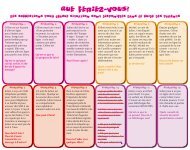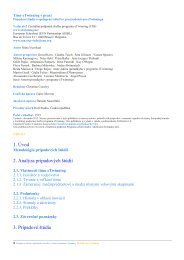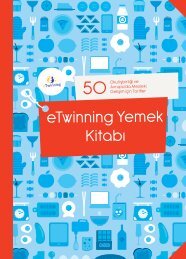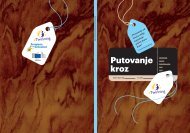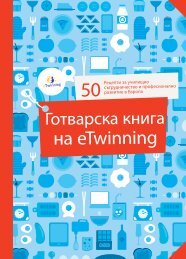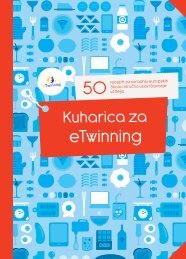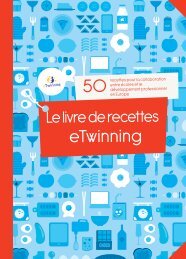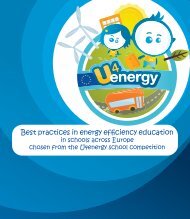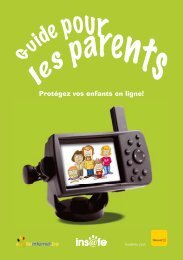Impact of data loggers on science teaching and learning - European ...
Impact of data loggers on science teaching and learning - European ...
Impact of data loggers on science teaching and learning - European ...
- No tags were found...
You also want an ePaper? Increase the reach of your titles
YUMPU automatically turns print PDFs into web optimized ePapers that Google loves.
<str<strong>on</strong>g>Impact</str<strong>on</strong>g> <str<strong>on</strong>g>of</str<strong>on</strong>g> <str<strong>on</strong>g>data</str<strong>on</strong>g> <str<strong>on</strong>g>loggers</str<strong>on</strong>g> <strong>on</strong> <strong>science</strong> <strong>teaching</strong> <strong>and</strong> <strong>learning</strong>Selecti<strong>on</strong> <str<strong>on</strong>g>of</str<strong>on</strong>g> pilot schoolsNine schools from six countries (France, Germany, Italy, Spain, Turkey, United Kingdom) wereselected to be part <str<strong>on</strong>g>of</str<strong>on</strong>g> the pilot. In total, the pilot study involved about 200 pupils <strong>and</strong> 30 teachers.The pilot schools were part <str<strong>on</strong>g>of</str<strong>on</strong>g> the <strong>European</strong> Schoolnet-Acer Educati<strong>on</strong>al Netbook pilot.Selecti<strong>on</strong> <str<strong>on</strong>g>of</str<strong>on</strong>g> schools was d<strong>on</strong>e in two steps. A first selecti<strong>on</strong> was made <strong>on</strong> the basis <str<strong>on</strong>g>of</str<strong>on</strong>g> thepedagogical plan <str<strong>on</strong>g>of</str<strong>on</strong>g> the netbook pilot school as well as <strong>on</strong> the number <str<strong>on</strong>g>of</str<strong>on</strong>g> <strong>science</strong> classesinvolved in the netbook pilot <strong>and</strong> <strong>on</strong> age <str<strong>on</strong>g>of</str<strong>on</strong>g> pupils. This pilot sought to include different agegroups to enable comparis<strong>on</strong>s <strong>and</strong> larger analysis. The sec<strong>on</strong>d selecti<strong>on</strong> step was madethrough the launch <str<strong>on</strong>g>of</str<strong>on</strong>g> a call am<strong>on</strong>g these schools. The final selecti<strong>on</strong> aimed to guaranteebalanced presence <str<strong>on</strong>g>of</str<strong>on</strong>g> age groups, subjects <strong>and</strong> countries in the pilot.Learning resources: the <strong>science</strong> experimentsTo allow comparis<strong>on</strong>, a limited set <str<strong>on</strong>g>of</str<strong>on</strong>g> activities was chosen – eight experiments were proposed– but it still allowed a certain flexibility <strong>on</strong> the activities: two or three experiments per subject.Teachers had to choose the most appropriate <strong>on</strong>es for their less<strong>on</strong>s. A technical guide <strong>on</strong>experiments translated into all project languages was made available to the teachers.Selecti<strong>on</strong> <str<strong>on</strong>g>of</str<strong>on</strong>g> experimentsBefore the project started, sixteen basic experiments in chemistry, physics <strong>and</strong> biology wereselected for their relevance to the <strong>European</strong> <strong>science</strong> curriculum, as this is an important factor forintegrati<strong>on</strong> into classroom activities (Flick, Bell, 2000). A survey submitted to the twenty-twoc<strong>and</strong>idate schools enabled us to identify the experiments most relevant for their less<strong>on</strong>s <strong>and</strong> agegroups <strong>and</strong> most likely to be integrated into <strong>science</strong> less<strong>on</strong>s by the participating teachers. In eachsubjects, experiments relevant for more than 45% <str<strong>on</strong>g>of</str<strong>on</strong>g> teachers (<strong>and</strong> up to 80%) were selected.C<strong>on</strong>tent <str<strong>on</strong>g>of</str<strong>on</strong>g> experimentsThere were two experiments selected for biology classes: the greenhouse effect <strong>and</strong> effect<str<strong>on</strong>g>of</str<strong>on</strong>g> ventilati<strong>on</strong> <strong>on</strong> heart rate; three for chemistry: freezing <strong>and</strong> melting <str<strong>on</strong>g>of</str<strong>on</strong>g> water; endothermicreacti<strong>on</strong> (reacti<strong>on</strong> <str<strong>on</strong>g>of</str<strong>on</strong>g> citric acid soluti<strong>on</strong> with baking soda), acid rain; <strong>and</strong> three for physics:measurements (finding the spring c<strong>on</strong>stant), c<strong>on</strong>verting potential <strong>and</strong> kinetic energy; positi<strong>on</strong><strong>and</strong> velocity measurements. Table 1 describes the c<strong>on</strong>tent <strong>and</strong> durati<strong>on</strong> <str<strong>on</strong>g>of</str<strong>on</strong>g> the activities.11



